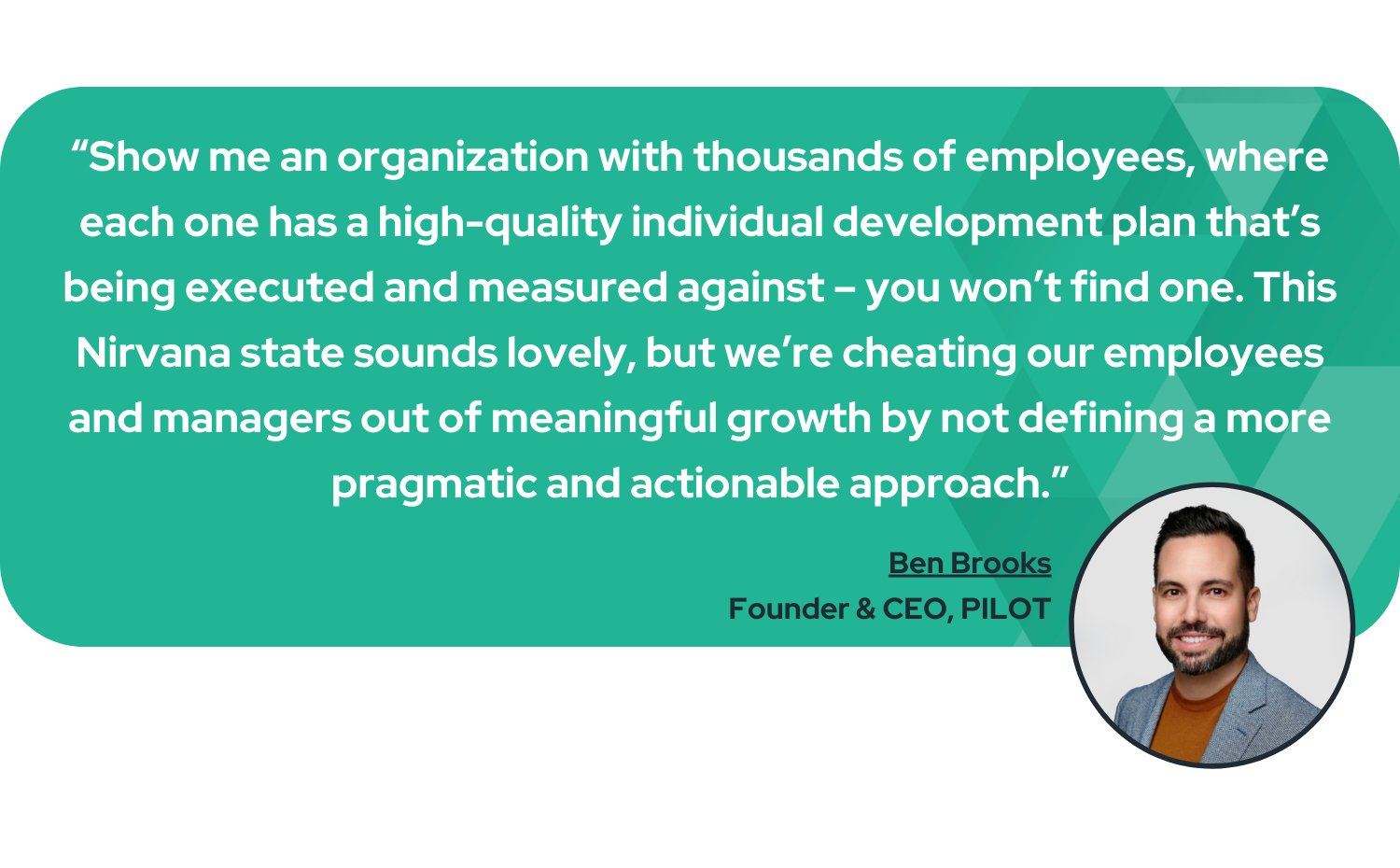How to Create an Employee Development Plan That Actually Gets Implemented
How many times have you helped create an employee development program that seemed great in concept, but failed during implementation?
At PILOT, our mission is to build employee development plans that truly work, and one of the keys to our success is that we show leaders how to create employee development plans that gain real traction.
There are a number of common mistakes we see among HR leaders around employee development plans. Failing to properly plan and implement a development program can greatly impact retention—94% of employees say they would stay with their employer if leadership was invested in their development. Instead, these ineffective programs leave employees feeling like there’s a lack of investment in their career.
In this article, we’ll look at the common reasons employee development plans fail to gain traction. Then, we’ll discuss how to create an employee development plan that actually gets implemented.
Common HR Misconceptions About Employee Development
You already know the statistics, but they bear repeating: employees want to know they can grow within your organization. According to Gallup, 59% of millennials say they find development opportunities “extremely important” when deciding whether to apply for a position. The Forbes Human Resource Council similarly demonstrated that engaged employees tend to stay with an employer longer, and are more likely to support business goals.
Despite this, traditional employee development plans often miss the target to actually develop employees, mostly due to a pervasive set of misconceptions:
Misconception 1: Personalization is the Key to Successful Employee Development
Everyone has their own unique, very specific development needs. That’s why HR leaders often advance development programs that emphasize finding and addressing those needs.
Individual development plans can be a great idea, but you need to be cognizant of the amount of support that’s needed to make them effective. In reality, there’s an 80/20 rule of development. Simply put, most people—especially individual contributors up to senior managers and lower level executives—have very similar needs.
The highest ROI comes from addressing the 80% of shared needs, rather than the 20% of individual needs.
Focus the highly personalized development programs on senior executives.
Misconception 2: Managers Must Develop the Skills to Become True Talent Managers
HR teams often aspire to turn their managers into true talent managers, with the ability to assess, coach, develop, and mentor all of their teams.
This may sound desirable, but it’s a huge reason that development programs fail. We are likely asking too much of managers if in addition to doing their individual work and supporting and managing their teams, we are also asking them to lead the charge in terms of developing their employees.
Misconception 3: Performance Management and Employee Development Conversations Should Be Intertwined
For most organizations, employee development conversations coincide with performance management conversations. And that’s not surprising, because these two conversations are seen as a means to assess potential and align employee growth with immediate organizational needs.
In the recent report More Harm Than Good: The Truth About Performance Reviews, Gallup research discovered that only 14% of employees “strongly agree” their performance reviews inspire them to improve.
The problem is that a quarterly or annual cadence is far too infrequent for employees to feel like they are developing. And it puts way too much pressure on a single conversation for both sides.
In a conversation where promotion and compensation is involved, development is going to be the third wheel. Decoupling these conversations is imperative to building a development program that gets results.
Misconception 4: Once Development Plans Are Created, They Will Be Executed
HR organizations often focus on getting development plans in place. And once you have those development plans done, some celebration is in order—the work is done!
This is one of the biggest reasons employee development programs fail. As we just touched on, many managers simply aren’t equipped to define and build out a learning or development journey to support the plan.
Even if you have the talented managers to do this, the next roadblock comes to the employees themselves. Rarely do they just comply with their development plans and own their development.
This leads to a final trap: lack of measurement or management. Development programs don’t gain traction without both measurement and management. Left to their own devices, managers and employees won’t pick up the slack… leaving these carefully crafted development plans sitting unused.
So how do you actually create an employee development plan that gets implemented?
Truths About How to Create An Employee Development Plan That Actually Gets Implemented
To actually gain traction for employee development, you’ll need to throw these misconceptions out the window. That starts with taking a fresh look at your employee development plans.
1. Rethink What Good Looks Like for an Employee Development Plan
Most development plans are complex and overwhelming for everyone involved.
Start by cutting out 90% of the typical inputs and content of what you would have in a standard plan. Then, create a few examples of development plans that could fit on a postcard. Share them with your organization!
Development plans should be straightforward, focusing on a single objective at a time with clear and actionable steps. This ensures your program will see tangible results. Shift your focus from annual or multi-year plans to more recurring, iterative, dynamic plans that are continually updated.
2. Enable Managers and Employees to Create Plans
Supporting both employees and managers in discovering their personal motivations in relation to development shifts the focus away from merely serving the organization's immediate needs to nurturing an engaged workforce.
The key is to shift away from overly complex plans and instead focus on serving the 80% of shared needs across the organization. Here are a few tips for accomplishing that:
Leverage already existing competencies, organizational values, or operating principles to create a menu of potential developmental objectives.
Create a menu of potential actions or interventions that already exist, including HR and L&D resources that may live in your LMS or HR portal.
Provide your managers and employees with easy-to-use templates and consumer-grade tools.
3. Empower Employees to be Responsible for Owning their Development Plans
It is crucial for managers to pivot away from traditional supervisory roles that breed dependency towards a developmental mindset that instills a sense of agency and self-direction in their teams. This transaction can be facilitated through access to training courses, group coaching experiences, and user-friendly tools aimed at empowering managers to champion the cause of employee development.
Coaching and mentoring programs help employees realize that they must be the primary owners of their development. These initiatives underscore the responsibility of the employees as the primary drivers of their own growth, ensuring that development is seen not as a sporadic event tied solely to promotions or formal education, but as a continual process integrated into their regular interactions with managers.
This is a core tenet of PILOT’s coaching program: we believe empowering people to own their careers is the best way to develop talent. And it works! Our programs typically result in a 20% or higher increase in intent-to-stay metrics.
Download this eBook to Learn Five Ways to Create Employee Development for Your Employees!
By incorporating career growth discussions into routine 1:1 meetings, employees are encouraged to consistently reflect upon and work towards their development goals, fostering a culture of ongoing improvement.
4. Encourage Continuous Feedback & Mentoring
Development is an ongoing journey, which is why embedding regular developmental feedback is crucial. After all, you and your employees go to work every day. There’s no reason to delay help that can be provided today—especially if it makes tomorrow better for everyone.
Continuous conversations focused on future growth provide a framework that encourages frequent and constructive feedback. This approach not only helps the worker, but it’s good for overall business. Data backs this approach up, too. 47% of HR leaders view employee experience as a top priority.
How PILOT Creates An Employee Development Program that Scales
Organizations need to shift away from viewing managers as developers, and instead putting development into the hands of employees themselves. PILOT emphasizes career ownership: empowering employees to take charge of their development.
Our fully virtual program is built upon four pillars that work: group coaching, individual reflection, executive fireside chats, and 1:1 manager feedback. And the foundation of those four pillars is career ownership.
This produces truly measurable results.
PILOT reimagines employee coaching, transforming it into a scalable, team-based experience.
Are You Ready to Create an Employee Development Plan That Works?
It’s time for HR leaders to rethink the status quo when it comes to employee development programs. By enabling people to create their own plans, empowering self-ownership of these plans, and gaining continuous feedback, your organization can start creating employee development plans – and actually see them get implemented.
Employees who feel empowered and understood are not only better at their jobs, but they make your business better. Are you giving your managers and their employees what they need to succeed?





